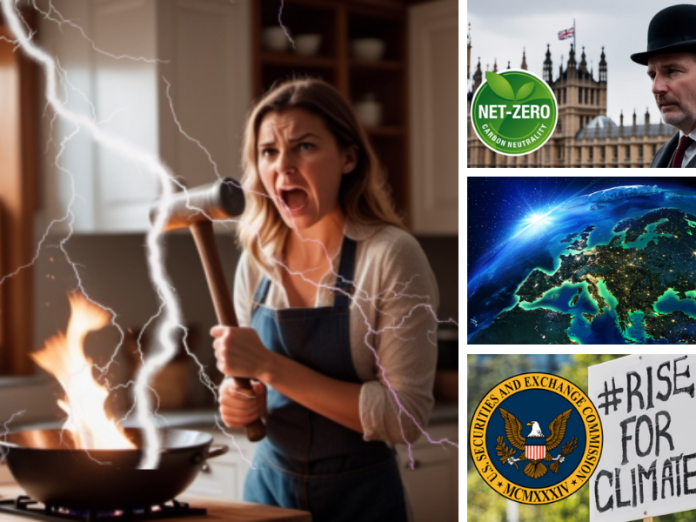YOU SHOULD SUBSCRIBE TO CLIMATE CHANGE WEEKLY.
IN THIS ISSUE:
- Proposed Climate Reporting Rule Is Foolish and Outside of SEC’s Mission, Study Shows
- Video of the Week: Mann vs. Steyn: Climate Trial of the Century Week 3 – Guest: Ann McElhinney
- Prominent British Institutions Uniformly Understated the Cost of Net Zero
- New Research Suggests Earth’s Climate Sensitivity Is Much Lower Than Usually Claimed
- Mandated Electrification of California Barred by Federal Court
- Podcast of the Week: Climate Change on Trial: Mann and God
- Climate Comedy
- Recommended Sites
Watch ALL the Presentations by the ALL-STARS of Climate Realism at the Archive of Heartland’s 15 Climate Conferences
New Research Further Demonstrates Problems with Surface Temperature Records and Models
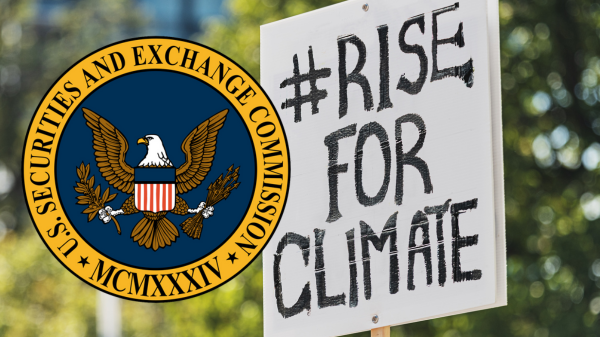
A new study by the Competitive Enterprise Institute (CEI) finds the climate disclosure rule being finalized by the U.S. Securities and Exchange Commission (SEC) “exceeds the commission’s statutory authority, undermines its existing disclosure-based framework, and greatly increases costs and work-hour burdens for companies subject to the mandate.”
When the SEC first broached the possibility of such a rule in 2022, I offered an official comment. I wrote, in part,
The SEC’s proposed climate accounting and disclosure rules fall well outside its legal mission to protect investors from fraud and the markets from insider trading and manipulation.
The factors likely to materially affect the success or failure of publicly traded companies are best known to the officers and managers of the firms and funds themselves, not the SEC, other regulatory agencies, politicians, or self-appointed stakeholders, including climate activists, not actively involved in the relevant business.
The effects of climate change 20, 30, 50, or 100 years from now are unknown and unknowable. …
The SECs proposed rules would require publicly traded companies to track and report on the greenhouse gas emissions resulting from their own operations and those of companies in their supply chain and the electric utilities that supply them power. In addition, companies would have to determine and report on how climate change is affecting their businesses now, how it is likely to affect them in the future, and what they are doing in response, including steps they are taking to reduce non-toxic greenhouse gas emissions.
These rules would take hundreds of millions, possibly billions, of dollars away from businesses core operations, to carry out the SECs mandate to predict future climate to account for its fiscal effect on business operations, and act as their brothers’ keepers by tracking their power companies and suppliers’ emissions as well as their own.
The SEC does not possess the statutory power to deputize or empower officers of publicly traded corporations to act as agents of the state to seek information from other companies under its regulatory control, much less from individuals or companies not under its regulatory purview.
CEI Research Fellow Stone Washington’s analysis confirms my own and goes beyond it to detail the myriad failings of the rule. Taken together, these flaws undermine any legitimate case the SEC might assert for its climate disclosure rule. CEI’s press release about the study states,
Under the SEC’s proposed rule, companies must report how climate change risk factors influence their financial decisions, business, models, locations, and projects. Regulated companies will be required to capture and report data on their direct, indirect, and value-chain produced greenhouse gas (GHG) emissions.
By capturing data from regulated companies’ value-chain—known in the rule as Scope 3 emissions (Scope 1 are direct emissions, Scope 2 are indirect emissions)—the rule would greatly expand the SEC’s regulatory reach, allowing it to demand information from a host of private entities that are not usually the target of the commission’s regulatory powers. The rule’s requirements would harm many non-regulated suppliers, including farmers, ranchers, and facility owners, simply because they do business with a registered company.
[T]he climate disclosure rule’s Scope 3 mandate will compel unregulated private companies to turn over sensitive GHG emissions data to registered firm partners. This backdoor regulation will likely be deemed by a reviewing court to compel information that is financially immaterial.
In his study, Washington says the proposed rule has all sorts of legal problems:
The SEC’s current climate rule now seeks to radically redefine established standards of materiality. This defies the Supreme Court’s Northway decision, previous agency precedent, and the agency’s statutory authorization … [and] violates the nondelegation doctrine, specifically the “major questions doctrine.”
In addition to the lack of appropriateness and legality of the rule, it is impractical. Washington estimates the rule will impose an additional $864,000 or more of annual disclosure costs for the average firm, with firms being forced “to hire lawyers, accountants, and ESG experts to contend with the rule’s estimated 39 million additional hours of paperwork.”
Large companies can absorb such costs, but smaller ones will struggle. The rule will force them to increase their prices or divert scarce resources from their core operations. Either way, their operations will be made less competitive with those of larger firms. On top of all that, the SEC has requested an additional $101 million in funding from Congress to hire new ESG-focused staff—more deficit spending for President Biden’s all-of-government approach to fighting climate change.
In a recent article on the SEC’s rule, I noted an additional problem:
If a company reported in its public documents and to the SEC that it did not expect climate change to materially affect its operations, whether because its board did not consider climate change a serious threat based on real-world data, or because it had no way of anticipating the types of weather events that might occur in the future, where, or when, it would be honest. However, it is doubtful that such honesty of a conclusion on the part of a company would satisfy the SEC’s climate mandarins.
Indeed, although the rule would do nothing to prevent climate change, because no single company or industry substantially impacts global warming, it would open regulated companies up to potential enforcement actions from the SEC and lawsuits from activists for “improper filing,” if the SEC isn’t satisfied with the filing or the anticipated impacts do not occur but other unforeseen impacts do occur that do materially affect the company’s profitability.
What should we conclude about the SEC’s rule? Washington has an answer:
In its current form, the SEC’s proposed climate disclosure rule will lead to expanded red tape, huge compliance costs, lawsuits, and little meaningful disclosure. Thus, the SEC should reconsider implementing the rule … and focus on its statutory mission of collecting disclosures of financially relevant information.
I wholeheartedly concur.
Sources: Competitive Enterprise Institute; Securities and Exchange Commission; American Thinker
Get your Copy at Amazon TODAY!
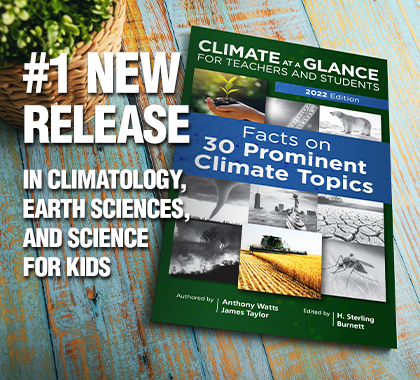
Video of the Week
In this episode of Climate Change Roundtable we review the end of the third week of the defamation trial in which climate “hockey stick” inventor Michael Mann is suing Mark Steyn and Rand Simberg. If you missed any bit of the the Climate Trial of the Century, this is your catch-up moment. You’ll see how the hockey stick itself is being broken into pieces in public.
Ann shares her observations with host Anthony Watts and panelists H. Sterling Burnett, Linnea Lueken, and Jim Lakely.
Read the brutal truth about how battery production for electric vehicles cause immense environmental destruction and human tragedy.
Global Hurricane Update: No Detectable Change Despite Warming
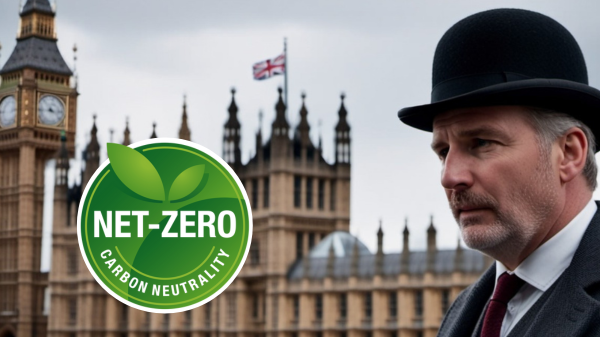
The United Kingdom has embraced the goal of going net zero, committing to producing no net carbon dioxide emissions by 2050, to fight climate change.
At the time of this commitment the government claimed the country could maintain reliable, affordable electric power without producing greenhouse gases, based largely on four different analyses: the U.K.’s Climate Change Committee (CCC), a public body created to advise the government and Parliament on responding to climate change; the National Infrastructure Commission (NIC); Britain’s National Grid Electric System operator (ESO); and The Royal Society.
A subsequent investigation, in part by the U.K.’s Telegraph and partly by the Royal Society itself, found these analyses relied on modelling of future climate conditions based on a single year of data or a representative “average year” for possible wind and solar conditions, or treated energy demand as constant, not increasing over the decades with population and economic growth. By ignoring other possible years’ data and assuming energy demand would not change (using a past year’s demand as a reference), each of the analyses grossly underestimated the costs of going Net Zero, in part by underestimating how much storage capacity would be necessary to keep the electric power grid on.
Reporting on The Royal Society’s examination of the CCC’s analysis, the Telegraph notes Sir Chris Llewellyn Smith led the society’s study of future energy supply and found the CCC’s report “looked at a single year” of data on the number of windy days, and the Committee “conceded privately that that was a mistake.” CCC chief executive Chris Stark told Smith treating a single year’s wind data as representative of all years was problematic and the Royal Society’s concern represented “an entirely valid criticism.”
The NIC study did the same thing, treating one year’s wind data as if it were an accurate representation of every year, despite having been informed by the U.K.’s Met office that low wind years often clustered together. The Met office has subsequently critiqued the NIC’s analysis.
Paul Homewood, who operates the blog Not a Lot of People Know That, looked into the ESO’s Future Energy Scenarios and found it had done the same thing, using weather conditions from 2013 to forecast the expected wind supply in 2050.
The Royal Society did not make this mistake. It examined 37 years of wind data in its analysis. However, it treated energy demand as constant, which is unrealistic for a variety of reasons, such as population growth, economic growth, and the fact that electric appliance and electric vehicle mandates will increase the demand for electricity. Smith admitted as much in a 2023 podcast interview. As reported by Watts up With That, Smith said, “And now I confess something that is a bit of a weakness in our report. We’ve got this model of one year of demand … based on the weather in 2018. …We simply repeat that 37 times.”
In light of these and other errors, it is estimated that up to more than twice as much electric capacity may well be needed in 2050 to reach Net Zero. This will dramatically increase the cost of electricity, because batteries are the primary electric power storage source, they are the most expensive source of electric power, and they operate only for relatively short periods of time before becoming fully discharged.
Source: Watts Up With That; The Telegraph; National Renewable Energy Laboratory
Heartland’s Must-read Climate Sites



New Research Suggests Earth’s Climate Sensitivity Is Much Lower Than Usually Claimed

Recent research published in the Journal of Climate suggests the Earth’s sensitivity to a doubling of carbon dioxide is 39 percent less than the globally averaged estimate, because of several factors the climate models persistently get wrong.
The Journal of Climate study concludes doubling CO2 from 380 to 760 ppm yields only 2.26 W/m² of forcing at the top of atmosphere (TOA) energy budget, which is 39 percent below the IPCC’s global-average estimate of 3.7 W/m².
The authors identified a number of other differences between the climate model projections, statements made by the IPCC, and the findings of their research. The study found TOA sensitivity and associated temperatures were highly variable and dependent on latitude. As a result, in some locations, such as over Antarctica, doubled CO2 resulted in lower temperatures, contradicting IPPC claims that climate sensitivity is greater at the poles. The result undercuts claims that Antarctic ice melt and any resulting sea level rise are driven by CO2.
The study also suggests that, rather than CO2 increasing the climate warming effect of water vapor as feedback, as assumed in climate models and by the IPCC, in fact water vapor reduces any forcing caused by rising carbon dioxide. “The water vapor usually damps the [doubled CO2] forcing by reducing the energy additional CO2 can absorb,” write the authors on this point.
Sources: No Tricks Zone
Mandated Electrification of California Barred by Federal Court

A new paper from author and energy analyst Robert Bryce discusses the importance of a late-January ruling by the Federal Ninth Circuit Court of Appeals denying the city of Berkeley, California’s petition to rehear a case that overruled the government’s ban on new natural gas hookups. The court previously held the ban was illegal under federal law. Bryce writes,
The January 2 ruling has national implications and is an enormous loss for the electrify everything movement, the lavishly funded campaign that seeks to ban natural gas stoves, water heaters, and other gas-fired appliances in the name of climate change.
The case is representative of a larger war on fossil fuels which threatens America’s energy security and reliability because the electrify-everything and dark money campaigners “want to add massive amounts of new load onto an energy network that is already cracking under existing demand,” Bryce writes.
The “electrify-everything movement” wants to limit consumers to electric cars, furnaces, water heaters, and stoves, and the same for industrial activities. These moves will increase electric power demand, as will expected population and economic growth. Meanwhile, electric power regulators are warning that the existing power grid is already overtaxed and prone to increasing outages, caused in part by increasing replacement of reliable power sources not dependent on the weather. Bryce notes,
Last August, the North American Electric Reliability Corporation named “changing resource mix” as a top reliability risk facing the electric grid. And for the first time, it named climate policy as one of the most significant risk factors.
It said, “Policy decisions can significantly affect the reliability and resilience of the [bulk power system]. Decarbonization, decentralization, and electrification have been active policy areas.
“Implementation of policies in these areas is accelerating, and, with changes in the resource mix, extreme weather events, and physical and cyber security challenges, reliability implications are emerging.”
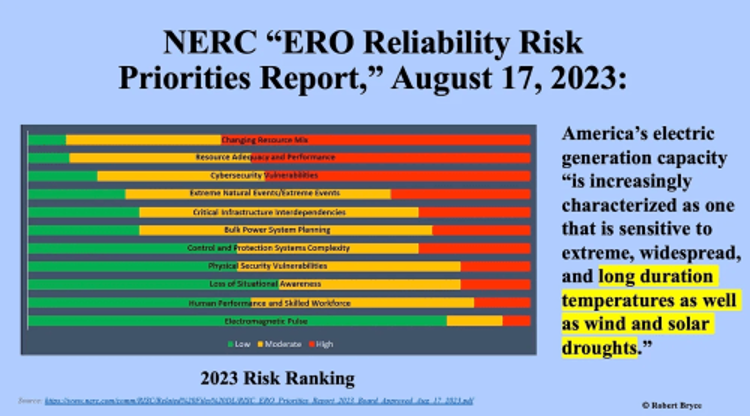
… NERC is warning that our grid is increasingly vulnerable to “wind and solar droughts.” If climate change means we are facing more extreme weather of all types, the last thing we should do is make our grid more dependent on the weather.
That brings us back to the importance of the Ninth Circuit court’s decision not to rehear Berkeley’s case. If the city’s gas ban is illegal, then so are other such bans in California and in other cities, counties, and states under the court’s jurisdiction: Alaska, Arizona, California, Hawaii, Idaho, Montana, Nevada, Oregon, and Washington.
Berkeley was joined in its request for a rehearing by the Biden administration, other cities and states, and conservation groups. Unless they can successfully appeal the ruling to the U.S. Supreme Court, the Ninth Circuit’s ruling is final, and similar gas bans imposed by 76 counties or states, including those in Seattle, Washington and Eugene, Oregon, will remain void.
Consumer freedom for the covered appliances has been restored in those jurisdictions despite the best efforts of climate scolds to dictate how people light and heat their homes, cook their meals, and do laundry. That means the future demand for electricity in the state and region will not be further taxed by government mandates for additional load.
Commenting on the ruling, California Restaurant Association lawyer Sarah Jorgensen said the court recognized “energy policy was a matter of national concern and that there should be uniform national regulation,” Bryce reports.
Source: Robert Bryce
Podcast of the Week
You’ve heard of Climategate, but now we bring you: Stalkergate. It was a day of high drama, both inside and outside the courthouse.
This trial of the century is rapidly coming to its close. In today’s episode, you’ll hear from five separate witnesses for Mark Steyn and Rand Simberg. There is a theme running through all the testimony: Witness after witness spoke about how Mann was the driver of the bullying and vindictive tone of the climate debate both before and after the Climategate scandal.
We also got to hear some of the science behind the criticism of the hockey stick, and how the investigation into Mann’s scientific misconduct was secretly guided by former Penn State president Graham Spanier.
The day ended with Mann’s lawyers making a false statement to law enforcement and almost getting a certain journalist assaulted. We ask, does Michael Mann have the lawyers he deserves?
Subscribe to the Environment & Climate News podcast on Apple Podcasts, iHeart, Spotify or wherever you get your podcasts. And be sure to leave a positive review!
Climate Comedy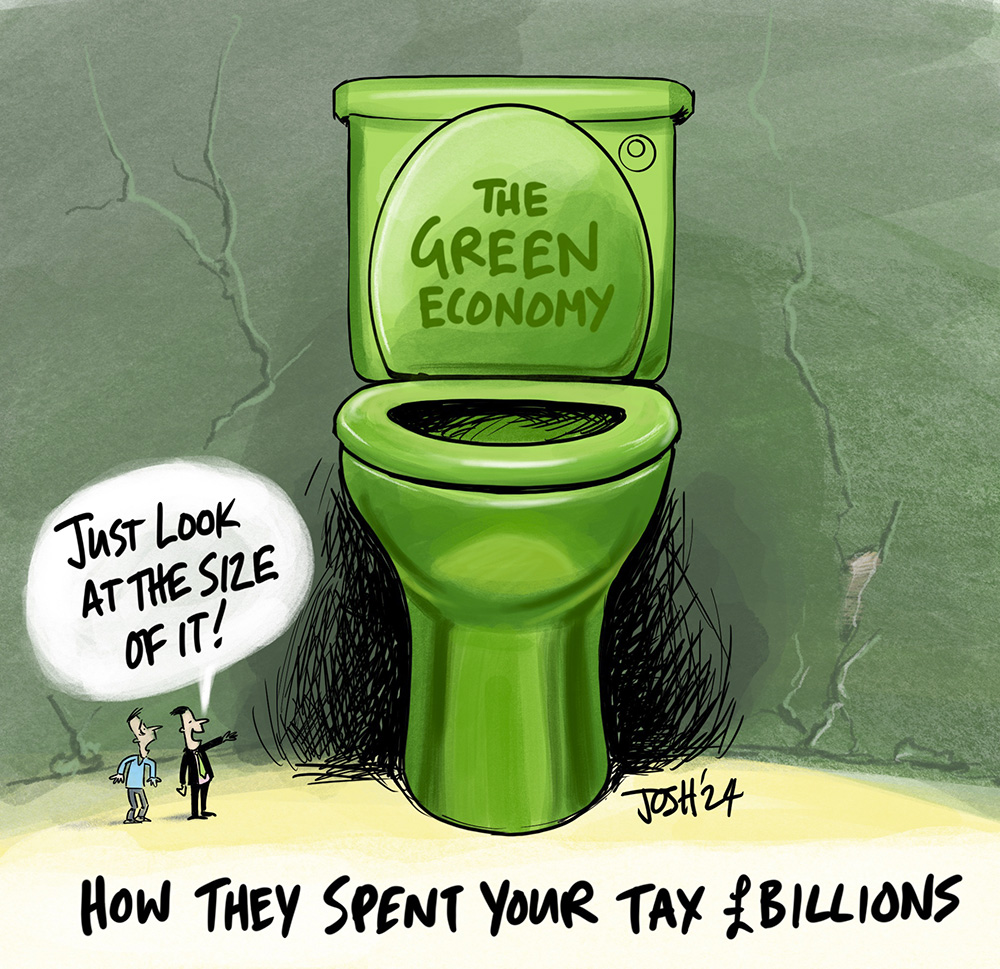
via Cartoons by Josh


